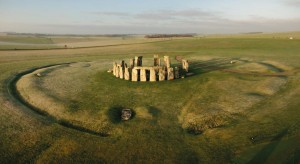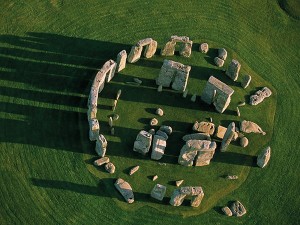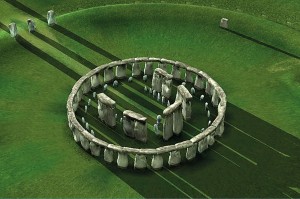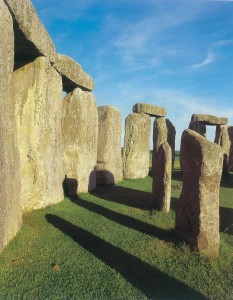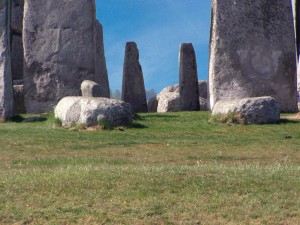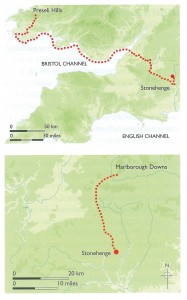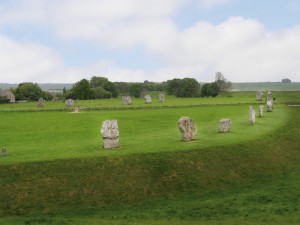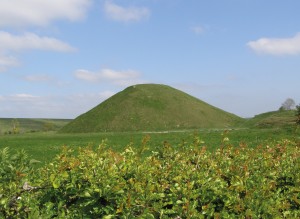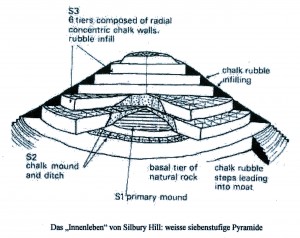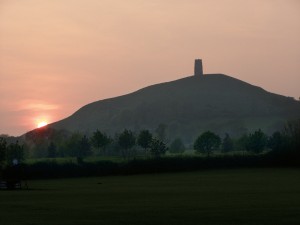STONEHENGE (England)
6.2 Power place
Names
– The name “Stonehenge” comes from the old English term “Stanhen gist”, which means “hanging stones”.
– However, the ending “-henge” is also used for other buildings from the Neolithic Age that are made up of a circular enclosing wall and an enclosed recess, such as nearby Woodhenge.
Geomancy
Stonehenge is located in the southern English county of Wiltshire. Almost two-thirds of the hilly plains that characterize the landscape from the Dorset Downs in the west to Dover in the east and from the Marlborough Downs in the northeast to Cranborn Chase in the southwest, rest on chalk formations. The monumental megalithic complex itself is situated on the Salisbury Plain on a flat, treeless landscape between Amesbury and Shrewton. Surrounding the site is nothing but pasturage (and the access road).
Point of power
Stonehenge lies on a grid line crossing point. The energy is light and airy.
– Correlates with sacred chakra, feelings
– Color: orange
– Dominant elements: earth and air
– Corresponding place: Arudy/Lourdes, France
6.3 Main structures
The Stonehenge complex and its surrounding structures have been well researched, revealing that the structure was built in three to five phases (sources differ on this point) over the course of 2,000 years. The fact that it was recognized and used as a sacred place long before the monoliths were erected has also been documented. The oldest scientific evidence, the three large postholes from the Mesolithic Age (immediately adjacent to the present-day car park), dates back to 8,000 BC. Cremation from 3,030 BC and 2,340 BC have also been documented; they prove that there was a burial ground near the site, as we have seen at other power points. We will look into this further when we come to “History” and “Builders”, but first let us turn to an outline of the exterior complex and the stone rings in the center.
Salisbury Plain is England‘s largest and most important center of pre-historic sites and settlements; the few kilometers immediately surrounding Stonehenge are home to more pre-historic sites than any other part of the islands. The structures are extremely varied and served different purposes during different epochs.
Embankment
This earth embankment, with a diameter of 115 m, forms the outermost circle around Stonehenge. It is around two meters high and bordered by a ditch. The large entrance lies to the northeast and the small one to the south (see Figure 6.10). We should keep in mind that its builders had neither pickaxes nor shovels. All the ditches, embankments and holes were dug using the points of stag antlers, while the shoulder blades of cattle were used as shovels to move the debris and earth.
The Aubrey Holes
(Named after their 17th-century discoverer, historian John Aubrey)
Within and along this embankment ring are 56 holes in the ground that indicate that there was a wooden structure within the border (similar to Woodhenge, which soon followed) in the early third century BC.
According to the most popular theory, the wooden posts served as alignment for the construction of the stone circles, after which they were filled in again (many of these postholes contained human ashes that were laid to rest two centuries after construction, including the small rings of the 30 Y and 28 Z holes).
The second theory, to which I subscribe, asserts that the posts were part of the astronomical site (see “Purpose of the Site”, page 300). These wooden posts, likely about two meters high, showed the cycles of the sun and the moon within the stone circles of Stonehenge. Much like the later sundials, these 56 posts formed an astronomical clock in which the cycles of the sun and the moon where depicted on the outer side of the stone circles.
Further posts stood at the north entrance and a parallel post formation led from the south entrance into the interior of the structure.
Stonehenge (stone circles)
In the center of the earth embankment are the four actual stone circles of sarsen and bluestones.
1. The outer circle has a diameter of 30 m and consists of 30 vertical sarsen stones. They are all about 4 m high, 2 m wide, 1 m broad and each weighs nearly 30 t. They were originally covered with a continuous ring of 30 cover stones that were connected to the standing monoliths and stabilized with pegs fit into holes on the monoliths’ tops. These cover stones alone weigh seven tons, which indicates a very special construction technique – one which actually should not have existed at the time – that enabled these stones to be hoisted five to six meters for setting and adjustment and then to lower them into place (two theories for this are depicted in Figures 6.43 and 6.44 in “Builders”).
2. The middle circle has a diameter of 24 m and was made up of 30 bluestones. At two meters, these are half as high as the outer ring and weigh about four tons. The top of the monoliths in this circle have also been hewn.
3. The inner circle has a diameter of 15 m and also forms the center of the structure with the five-sarsen stone trilithons consisting of three monoliths each, which actually do not form a circle, but a horseshoe shape. There are ten erect sarsen monoliths, each about 6 m high, 3 m wide, 1 m deep and weighing 45 t and, like those of the outer circle, are connected by a cover stone.
4. Within this horseshoe, in turn, are 15 bluestones of about the same measurements, three in front of each trilithon.
Many believe the monolith made of green sandstone (probably from Greensand Ridge, see page 297) in the center to be the so-called “Altar Stone”.
Today it measures five meters and is broken in two; since one piece that was broken off is missing, it was probably originally about one meter longer, for a total of about six meters. It originally marked the center.
Sarsen stones
The 75-sarsen stones originate from the “Marlborough Downs”, approximately 30 km away in Fyfield Down near Avebury, where stone circles with gigantic monoliths, which we will examine in “Structures in the Region”, also stand.
This means that the blocks of rock had to be transported overland, a route that Redhorn Hill, which could not be avoided, complicated greatly. English researchers calculate that it would have taken at least 1,000 men to pull the largest of the monoliths, which weighs nearly 50 t, up this hill. The theory that Stonehenge was built by the ancient Druids or the Windmill Hill or Bell Beaker peoples assume that the monoliths were loaded onto giant sleds and moved over a runway of tree trunks. The size of tree trunks necessary would have required six to eight men just to carry a tree trunk back to the front of the line. The towropes were supposedly made from braided strips of leather and cow hair. But, to transport a 25-ton block of stone (the average) using these rollers would have required at least 80-100 men over plains and several times that over hills. Based on these figures, the average distance would have been 800 m per day and it would have taken about 9 weeks to transport one such stone to Stonehenge. Extrapolating these figures shows that transporting just the 81-sarsen stones would have required about 1,500 men working about 16 hours a day for more than ten years. However, this is only possible on dry ground, so the time for transport increases to 20 years assuming that these conditions are met for six months each year.
Another theory claims that the monoliths were transported during winter because sleighs could be pulled much more easily over slippery snow and ice than monoliths over rollers and because the rural population would only have had time for this work in winter. The difficult carving of the very hard sarsen stones from sandstone that has been compressed over millennia raises more questions, because just as in Giza and Ollantaytambo, the people of the day had no tools that were harder than certain types of rock. The theory here claims that hammer heads or ax heads made from granite or sandstone were used –rocks can only be cut with other rocks of the same type or with harder materials. The shaping techniques used here, however, are incredibly difficult even with today‘s knapping techniques and tools. According to the latest extrapolations, chiseling out the cuboid forms and polishing the four sides of the 81 sarsen monoliths would have taken about three years (for 50 stonemasons working ten hours a day, seven days a week). There are also new calculations for the necessary number of workers, according to which at least 1,000 workers would have had to work non-stop and would have needed to work together for the 1,500,000 working hours of the three building phases. This does not account for the cost of extraction, knapping, transportation and construction; planning and coordination; administration; or board and shelter for the workers.
Bluestones
Their name comes from the blue sheen of the monoliths, which are made from various kinds of rock, but consist mostly of the basaltic diabase and rhyolite. However, basalt is a volcanic rock and does not exist in Stonehenge‘s limestone geology. The closest deposits are over 100 km away and then appear only in small chunks that cannot be used for such large monoliths. The question of just where the 80 roughly 2-meter tall blue stones came from, each weighing more than 300 tons, remained unanswered for many years. In 1923, geologist H. H. Thomas proved that they came from the Carn Menyn stone quarry in the Preseli Mountains in the Pembrokeshire highlands, a mountain range in southwestern Wales, around 380 km from Stonehenge. In November 2013, the archeologist Richard Bevin from the National Museum of Wales, published an article in the „Journal of Archaeological Science“ stating that, based on a new geochemical analysis, the blue stones actually came from Carn Goedog, around 1.6 kilometers from Carn Menyn.
There are three theories regarding the transport of the blue stones: the natural shifting by glaciers, or transport by the builders. Either via the 250 km direct overland route or nearly 400 km via combined sea, river and overland route, in which the 4 ton monoliths were transported on shops or rafts over water, a method that was also successfully proven by English researchers in the 1990s.
This is just a small excerpt from the book GAIA LEGACY.
6. STONEHENGE (England)
6.1 Landscape 269
– Geography 269
– Geology 270
– Climate 272
– Vegetation 273
6.2 Power place 274
– Names 274
– Geomancy 274
– Point of power 274
6.3 Structures 275
– Main structures 275
– Underground complexes 282
– Other structures in the region 282
– Temple structures 289
6.4 History 290
– Historic history 290
– Finds 295
– Prehistoric history 295
– Builders and peoples 296
– Original purpose 300
– Legends and myths 306
6.5 Spirit 318
– Religions and deities 318
– Spirituality and transmissions 322

